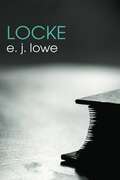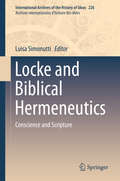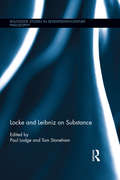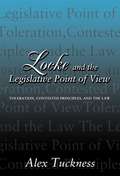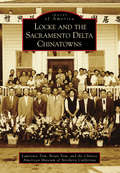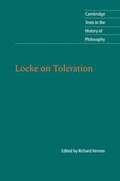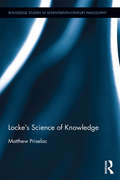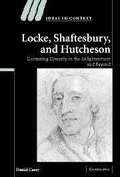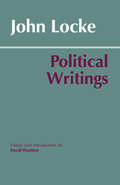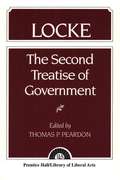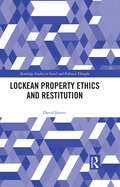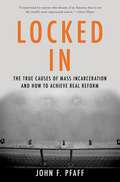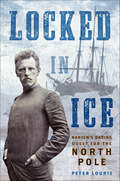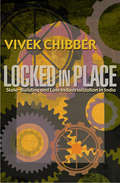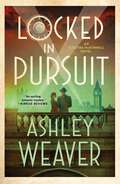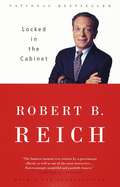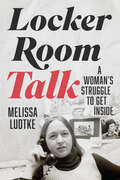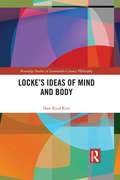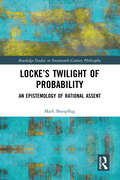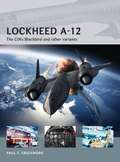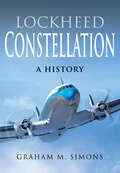- Table View
- List View
Locke (The Routledge Philosophers)
by E.J. LoweJohn Locke (1632-1704) was one of the towering philosophers of the Enlightenment and arguably the greatest English philosopher. Many assumptions we now take for granted, about liberty, knowledge and government, come from Locke and his most influential works, An Essay Concerning Human Understanding and Two Treatises of Government. In this superb introduction to Locke's thought, E.J. Lowe covers all the major aspects of his philosophy. Whilst sensitive to the seventeenth-century background to Locke's thought, he concentrates on introducing and assessing Locke in a contemporary philosophical setting, explaining why he is so important today.Beginning with a helpful overview of Locke's life and times, he explains how Locke challenged the idea that the human mind and knowledge of the external world rested on innate principles, laying the philosophical foundations of empiricism later taken up by Berkeley and Hume. Subsequent chapters introduce and critically assess topics fundamental to understanding Locke: his theories of substance and identity, language and meaning, philosophy of action and free will, and political freedom and toleration. In doing so, he explains some of the more complex yet pivotal aspects of Locke's thought, such as his theory that language rests on ideas and how Locke's theory of personal identity paved the way for modern empirical psychology. A final chapter assesses Locke's legacy, and the book includes a helpful chronology of Locke's life and glossary of unfamiliar terms.
Locke and Biblical Hermeneutics: Conscience and Scripture (International Archives of the History of Ideas Archives internationales d'histoire des idées #226)
by Luisa SimonuttiThe volume presents illuminating research carried out by international scholars of Locke and the early modern period. The essays address the theoretical and historical contexts of Locke’s analytical methodology and come together in a multidisciplinary approach that sets biblical hermeneutics in relation to his philosophical, historical, and political thought, and to the philological and doctrinal culture of his time. The contextualization of Locke’s biblical hermeneutics within the contemporary reading of the Bible contributes to the analysis of the figure of Christ and the role of Paul’s theology in political and religious thought from the seventeenth century to the Enlightenment. The volume sheds light on how Locke was appreciated by his contemporaries as a biblical interpreter and exegete. It also offers a reconsideration that overarches interpretations confined within specific disciplinary ambits to address Locke’s thought in a global historic context.
Locke and Leibniz on Substance (Routledge Studies in Seventeenth-Century Philosophy)
by Paul Lodge Tom StonehamLocke and Leibniz on Substance gathers together papers by an international group of academic experts, examining the metaphysical concept of substance in the writings of these two towering philosophers of the early modern period. Each of these newly-commissioned essays considers important interpretative issues concerning the role that the notion of substance plays in the work of Locke and Leibniz, and its intersection with other key issues, such as personal identity. Contributors also consider the relationship between the two philosophers and contemporaries such as Descartes and Hume.
Locke and the Legislative Point of View: Toleration, Contested Principles, and the Law
by Alex TucknessDetermining which moral principles should guide political action is a vexing question in political theory. This is especially true when faced with the "toleration paradox": believing that something is morally wrong but also believing that it is wrong to suppress it. In this book, Alex Tuckness argues that John Locke's potential contribution to this debate--what Tuckness terms the "legislative point of view"--has long been obscured by overemphasis on his doctrine of consent. Building on a line of reasoning Locke made explicit in his later writings on religious toleration, Tuckness explores the idea that we should act politically only on those moral principles that a reasonable legislator would endorse; someone, that is, who would avoid enacting measures that could be self-defeating when applied by fallible human beings. Tuckness argues that the legislative point of view has implications that go far beyond the question of religious toleration. Locke suggests an approach to political justification that is a provocative alternative to the utilitarian, contractualist, and perfectionist approaches dominating contemporary liberalism. The legislative point of view is relevant to our thinking about many types of disputed principles, Tuckness writes. He examines claims of moral wrong, invocations of the public good, and contested political roles with emphasis on the roles of legislators and judges. This book is must reading not only for students and scholars of Locke but all those interested in liberalism, toleration, and constitutional theory.
Locke and the Sacramento Delta Chinatowns (Images of America)
by Brian Tom Chinese American Museum of Northern California Lawrence TomChinese pioneers in the Sacramento River Delta were the vital factor in reclaiming land and made significant contributions to California's agricultural industry from farming to canning. Since the 1860s, Chinese were already settled in the delta and created Chinatowns in and between the two towns of Freeport in the north and Rio Vista in the south. One of the towns, Locke, was unique in that it was built by the Chinese and was inhabited almost exclusively by the Chinese during the first half of the 1900s. The town of Locke represents the last remaining legacy of the Chinese pioneers who settled in the delta.
Locke on Toleration
by John Locke Richard Vernon Michael SilverthorneJohn Locke's Letter Concerning Toleration (1689) is one of the most widely-read texts in the political theory of toleration, and a key text for the liberal tradition. However, Locke also defended toleration more extensively in three subsequent Letters, which he wrote in response to criticism by an Anglican cleric, Jonas Proast. This edition, which includes a new translation of the original Letter, by Michael Silverthorne, enables readers to assess John Locke's theory of toleration by studying both his classic work and essential extracts from the later Letters. An introduction by Richard Vernon sets Locke's theory in its historical context and examines the key questions for contemporary political theorists which arise from this major work in the history of political thought.
Locke's Science of Knowledge (Routledge Studies in Seventeenth-Century Philosophy)
by Matt PriselacJohn Locke’s An Essay Concerning Human Understanding begins with a clear statement of an epistemological goal: to explain the limits of human knowledge, opinion, and ignorance. The actual text of the Essay, in stark contrast, takes a long and seemingly meandering path before returning to that goal at the Essay’s end—one with many detours through questions in philosophy of mind, metaphysics, and philosophy of language. Over time, Locke scholarship has come to focus on Locke’s contributions to these parts of philosophy. In Locke’s Science of Knowledge, Priselac refocuses on the Essay’s epistemological thread, arguing that the Essay is unified from beginning to end around its compositional theory of ideas and the active role Locke gives the mind in constructing its thoughts. To support the plausibility and demonstrate the value of this interpretation, Priselac argues that—contrary to its reputation as being at best sloppy and at worst outright inconsistent—Locke’s discussion of skepticism and account of knowledge of the external world fits neatly within the Essay’s epistemology.
Locke, Science, and Politics
by Steven FordeIn this groundbreaking book, Steven Forde argues that John Locke's devotion to modern science deeply shaped his moral and political philosophy. Beginning with an account of the classical approach to natural and moral philosophy, and of the medieval scholasticism that took these forward into early modernity, Forde explores why the modern scientific project of Francis Bacon, Pierre Gassendi, Robert Boyle and others required the rejection of the classical approach. Locke fully subscribed to this rejection, and took it upon himself to provide a foundation for a compatible morality and politics. Forde shows that Locke's theory of moral 'mixed modes' owes much to Pufendorf, and is tailored to accommodate science. The theory requires a divine legislator, which in turn makes natural law the foundation of morality, rather than individual natural right. Forde shows the ways that Locke's approach modified his individualism, and colored his philosophy of property, politics and education.
Locke, Shaftesbury, and Hutcheson: Contesting Diversity in the Enlightenment and Beyond
by Daniel CareyAre human beings linked by a common nature, or are they fragmented by different cultural practices and values? These fundamental moral questions were debated in the Enlightenment by Locke, Shaftesbury, and Hutcheson. Daniel Carey explores the relationship between these founding arguments and contemporary disputes over cultural diversity and multiculturalism.
Locke: Political Writings
by John Locke David WoottonJohn Locke's Second Treatise of Government (c. 1681) is perhaps the key founding liberal text. A Letter Concerning Toleration, written in 1685 (a year when a Catholic monarch came to the throne of England and Louis XVI unleashed a reign of terror against Protestants in France), is a classic defense of religious freedom. Yet many of Locke's other writings--not least the Constitutions of Carolina, which he helped draft--are almost defiantly anti-liberal in outlook.This comprehensive collection brings together the main published works (excluding polemical attacks on other people's views) with the most important surviving evidence from among Locke's papers relating to his political philosophy. David Wootton's wide-ranging and scholarly Introduction sets the writings in the context of their time, examines Locke's developing ideas and unorthodox Christianity, and analyzes his main arguments. The result is the first fully rounded picture of Locke's political thought in his own words.
Lockean Property Ethics and Restitution (Routledge Studies in Social and Political Thought)
by David JarrettIn this book, David Jarrett argues that the influential Lockean thesis of justice in property, which traces back to John Locke, seems to entail much egalitarian property redistribution. Put briefly, Lockeans argue that people justly own: (1) any unowned natural resources they labour on, (2) any resources they receive via voluntary transfer from a legitimate owner, and (3) any resources they legitimately receive in compensation for harm done to their person or legitimately held property. However, a question that has been largely overlooked by Lockeans is how to address the problem of property which did not arise in line with Lockean justice. What do we do about property which derives from feudal and colonial conquest, for example? Drawing on a range of theoretical and historical sources, this book argues that the legal concept of restitution is the most reasonable way to address the problem. If we apply this concept, it appears that much property in the world is held unjustly and should be redistributed in an egalitarian manner. Lockean Property Ethics and Restitution will be of interest to political theorists and philosophers alike.
Locked In: The True Causes Of Mass Incarceration-and How To Achieve Real Reform
by John Pfaff"A succinct, powerful explanation of why much of what we think about the incarceration boom is probably wrong." --Bloomberg ViewA groundbreaking examination of our system of imprisonment, revealing the true causes of mass incarceration as well as the best path to reformIn the 1970s, the United States had an incarceration rate comparable to those of other liberal democracies-and that rate had held steady for over 100 years. Yet today, though the US is home to only about 5 percent of the world's population, we hold nearly one quarter of its prisoners. Mass incarceration is now widely considered one of the biggest social and political crises of our age. How did we get to this point? Locked In is a revelatory investigation into the root causes of mass incarceration by one of the most exciting scholars in the country. Having spent fifteen years studying the data on imprisonment, John Pfaff takes apart the reigning consensus created by Michelle Alexander and other reformers, revealing that the most widely accepted explanations-the failed War on Drugs, draconian sentencing laws, an increasing reliance on private prisons-tell us much less than we think. Pfaff urges us to look at other factors instead, including a major shift in prosecutor behavior that occurred in the mid-1990s, when prosecutors began bringing felony charges against arrestees about twice as often as they had before. He describes a fractured criminal justice system, in which counties don't pay for the people they send to state prisons, and in which white suburbs set law and order agendas for more-heavily minority cities. And he shows that if we hope to significantly reduce prison populations, we have no choice but to think differently about how to deal with people convicted of violent crimes-and why some people are violent in the first place. An authoritative, clear-eyed account of a national catastrophe, Locked In transforms our understanding of what ails the American system of punishment and ultimately forces us to reconsider how we can build a more equitable and humane society.
Locked in Ice: Nansen's Daring Quest for the North Pole
by Peter LourieA spellbinding biography of Fridtjof Nansen, the pioneer of polar exploration, with a spotlight on his harrowing three-year journey to the top of the world.An explorer who many adventurers argue ranks alongside polar celebrity Ernest Shackleton, Fridtjof Nansen contributed tremendous amounts of new information to our knowledge about the Polar Arctic. At a time when the North Pole was still undiscovered territory, he attempted the journey in a way that most experts thought was mad: Nansen purposefully locked his ship in ice for two years in order to float northward along the currents. Richly illustrated with historic photographs, this riveting account of Nansen's Arctic expedition celebrates the legacy of an extraordinary adventurer who pushed the boundaries of human exploration to further science into the twentieth century.Christy Ottaviano Books
Locked in Place: State-Building and Late Industrialization in India
by Vivek ChibberWhy were some countries able to build "developmental states" in the decades after World War II while others were not? Through a richly detailed examination of India's experience, Locked in Place argues that the critical factor was the reaction of domestic capitalists to the state-building project. During the 1950s and 1960s, India launched an extremely ambitious and highly regarded program of state-led development. But it soon became clear that the Indian state lacked the institutional capacity to carry out rapid industrialization. Drawing on newly available archival sources, Vivek Chibber mounts a forceful challenge to conventional arguments by showing that the insufficient state capacity stemmed mainly from Indian industrialists' massive campaign, in the years after Independence, against a strong developmental state. Chibber contrasts India's experience with the success of a similar program of state-building in South Korea, where political elites managed to harness domestic capitalists to their agenda. He then develops a theory of the structural conditions that can account for the different reactions of Indian and Korean capitalists as rational responses to the distinct development models adopted in each country. Provocative and marked by clarity of prose, this book is also the first historical study of India's post-colonial industrial strategy. Emphasizing the central role of capital in the state-building process, and restoring class analysis to the core of the political economy of development, Locked in Place is an innovative work of theoretical power that will interest development specialists, political scientists, and historians of the subcontinent.
Locked in Pursuit: An Electra McDonnell Novel (Electra McDonnell Series #4)
by Ashley WeaverThe fourth installment in Ashley Weaver's delightful series, Locked in Pursuit follows safecracker Electra McDonnell fighting Nazis at every turn as World War II looms over London.Safecracker Ellie McDonnell hasn’t seen Major Ramsey—her handsome but aloof handler in the British government—since their tumultuous mission together three months before, but when she hears about a suspicious robbery in London she feels compelled to contact him. Together they discover that a rash of burglaries leads back to a hotbed of spies in the neutral city Lisbon, Portugal, and an unknown object brought to London by a mysterious courier. As the thieves become more desperate and their crimes escalate, it becomes imperative that Ellie and Ramsey must beat them at their own game. Fighting shadowy assailants, enemy agents, and the mutual attraction they’ve agreed not to acknowledge, Ellie and Ramsey work together to learn if it truly takes a thief to catch a thief.
Locked in the Cabinet
by Robert B. ReichLocked in the Cabinet is a close-up view of the way things work, and often don't work, at the highest levels of government--and a uniquely personal account by the man whose ideas inspired and animated much of the Clinton campaign of 1992 and who became the cabinet officer in charge of helping ordinary Americans get better jobs. Robert B. Reich, writer, teacher, social critic--and a friend of the Clintons since they were all in their twenties--came to be known as the "conscience of the Clinton administration and one of the most successful Labor Secretaries in history. Here is his sometimes hilarious, sometimes poignant chronicle of trying to put ideas and ideals into practice. With wit, passion, and dead-aim honesty, Reich writes of those in Washington who possess hard heads and soft hearts, and those with exactly the opposite attributes. He introduces us to the career bureaucrats who make Washington run and the politicians who, on occasion, make it stop; to business tycoons and labor leaders who clash by day and party together by night; to a president who wants to change America and his opponents (on both the left and the right) who want to keep it as it is or return it to where it used to be. Reich guides us to the pinnacles of power and pretension, as bills are passed or stalled, reputations built or destroyed, secrets leaked, numbers fudged, egos bruised, news stories spun, hypocrisies exposed, and good intentions occasionally derailed. And to the places across America where those who are the objects of this drama are simply trying to get by--assembly lines, sweatshops, union halls, the main streets of small towns and the tough streets of central cities. Locked in the Cabinetis an intimate odyssey involving a memorable cast--a friend who is elected President of the United States, only to discover the limits of power; Alan Greenspan, who is the most powerful man in America; and Newt Gingrich, who tries to be. Plus a host of others: White House staffers and cabinet members who can't find "the loop ; political consultant Dick Morris, who becomes "the loop ; baseball players and owners who can't agree on how to divide up $2 billion a year; a union leader who accuses Reich of not knowing what a screwdriver looks like; a heretofore invisible civil servant deep in the Labor Department whose brainchild becomes the law of the land; and a wondrous collection of senators, foreign ministers, cabinet officers, and television celebrities. And it is also an odyssey for Reich's wife and two young sons, who learn to tolerate their own cabinet member but not to abide Washington. Here is Reich--determined to work for a more just society, laboring in a capital obsessed with exorcising the deficit and keeping Wall Street happy--learning that Washington is not only altogether different from the world of ordinary citizens but ultimately, and more importantly, exactly like it: a world in which Murphy's Law reigns alongside the powerful and the privileged, but where hope amazingly persists. There are triumphs here to fill a lifetime, and frustrations to fill two more. Never has this world been revealed with such richness of evidence, humor, and warmhearted candor.
Locker Room Talk: A Woman’s Struggle to Get Inside
by Melissa LudtkeWhile sportswriters rushed into Major League Baseball locker rooms to talk with players, MLB Commissioner Bowie Kuhn barred the lone woman from entering along with them. That reporter, 26-year-old Sports Illustrated reporter Melissa Ludtke, charged Kuhn with gender discrimination, and after the lawyers argued Ludtke v. Kuhn in federal court, she won. Her 1978 groundbreaking case affirmed her equal rights, and the judge’s order opened the doors for several generations of women to be hired in sports media. Locker Room Talk is Ludtke’s gripping account of being at the core of this globally covered case that churned up ugly prejudices about the place of women in sports. Kuhn claimed that allowing women into locker rooms would violate his players’ “sexual privacy.” Late-night television comedy sketches mocked her, as newspaper cartoonists portrayed her as a sexy, buxom looker who wanted to ogle the naked athletes’ bodies. She weaves these public perspectives throughout her vivid depiction of the court drama overseen by Judge Constance Baker Motley, the first Black woman to serve on the federal bench. She recounts how her lawyer, F.A.O. “Fritz” Schwarz, employed an ingenious legal strategy that persuaded Judge Motley to invoke the Fourteenth Amendment’s Equal Protection Clause in giving Ludtke access identical to that of her male counterparts. Locker Room Talk is both an inspiring story of one woman’s determination to do a job dominated by men and an illuminating portrait of a defining moment for women’s rights.
Locke’s Ideas of Mind and Body (Routledge Studies in Seventeenth-Century Philosophy)
by Han-Kyul KimThis book begins with a survey of various readings of Locke as a materialist, as a substance dualist, and as a property dualist, and demonstrates that these inconsistent interpretations result from a general failure of modern commentators to notice the significance of Locke’s ‘mind-body nominalism’. By illuminating this largely overlooked aspect of Locke’s philosophy, this book reveals a common mistake of previous interpretations: that of treating what Locke conceives to be ‘nominal’ as real. The nominal symmetry that Locke posits between mind and body is distinct from any form of metaphysical dualism, whether substance dualism or property dualism. It is a brand of naturalism, but does not insist that the material is ontologically more basic than the mental or that the former determines the latter. On this view, the material and the mental both relate solely to a certain set of functional roles, rather than to an intrinsic property that plays these roles. The term ‘matter’ is thus rendered vague, and materialism is conceived as a precariously grounded ontological doctrine. Elaborating on this interpretation of Locke’s Essay, this book examines the insightful readings of Locke developed by seventeenth- and eighteenth-century thinkers such as Richard Burthogge, William Carroll, and Joseph Priestley. This book also seeks to clarify what Locke’s position would look like in a modern setting by noting some significant parallels with the ideas of leading contemporary philosophers such as Donald Davidson, David Lewis, and Colin McGinn.
Locke’s Twilight of Probability: An Epistemology of Rational Assent (Routledge Studies in Seventeenth-Century Philosophy)
by Mark BoespflugThis book provides a systematic treatment of Locke’s theory of probable assent and shows how the theory applies to Locke’s philosophy of science, moral epistemology, and religious epistemology. There is a powerful case to be made that the most important dimension of Locke’s philosophy is his theory of rational probable assent, rather than his theory of knowledge. According to Locke, we largely live our lives in the “twilight of probability” rather than in “the sunshine of certain knowledge.” Locke’s theory of probable assent has far-reaching significance insofar as it contains a wealth of novel, independently interesting, and prescient elements that precede the modern field of formal epistemology. In this book, the author argues for the central role of probable assent in Locke’s philosophy. Locke’s theory of probable assent is based on an epistemic modesty that claims, roughly, that our cognitive abilities are limited and that we ought to carry ourselves in believing with due caution. This modesty motivates the author’s discussion of other aspects of Locke’s epistemology, notably his principle of proportionality, his doxastic involuntarism, his epistemological pragmatism, and his theory of testimony. The book concludes by connecting the theory of probable assent with Locke’s views on the limits of science, moral epistemology, and the rationality of faith. Locke’s Twilight of Probability will appeal to scholars and advanced students working on Locke and the history of early modern philosophy.
Lockheed A-12
by Adam Tooby Paul CrickmoreDuring the early years of the Cold War, the most effective way to gather strategic intelligence about the Soviet Union and its allies was manned overflight. Lockheed's U-2 was spectacularly successful in this role. Much to the concern of President Eisenhower, its shape meant that it could be tracked on Russian radars. Given the highly sensitive nature of such flights, the President insisted that every effort should be made to reduce to zero the U-2's radar cross section (RCS), thereby making the aircraft "invisible." When this was proven to be impossible, the stage was set for a U-2 replacement. Following a competition between Lockheed and Convair, the former was declared the winner and the result was the A-12. Designed to incorporate 'stealth' features before the term was even coined, the A-12 has to date proven to be the fastest, highest flying jet aircraft ever built, and is operated exclusively by the Central Intelligence Agency. This book will also cover a two-seat variation of the design built as an advanced interceptor - the YF-12. In addition, the D-21 drone programme, known as Tagboard will also be covered.
Lockheed Constellation: A History
by Graham M SimonsThis illustrated history &“recounts the unusual and sometimes dramatic development and operational career of one of the twentieth century&’s most iconic airliners&” (Aviation History Magazine). Clarence &“Kelly&” Johnson&’s design for the Lockheed Constellation, known affectionately as the Connie, produced one of the world&’s most iconic airliners. Lockheed had been working on the L-044 Excalibur, a four-engine, pressurized airliner, since 1937. In 1939, Trans World Airlines, at the instigation of major stockholder Howard Hughes, requested a forty-passenger transcontinental aircraft with a range of 3,500 miles, well beyond the capabilities of the Excalibur design. TWA&’s requirements led to the L-049 Constellation, designed by Lockheed engineers including Kelly Johnson and Hall Hibbard. Between 1943 and 1958, Lockheed built 856 Constellations in numerous models at its Burbank, California, factory—all with the same distinctive and immediately recognizable triple-tail design and dolphin-shaped fuselage. The Constellation was used as a civil airliner and as a military and civilian air transport, seeing service in the Berlin and the Biafran airlifts. Three of them served as the presidential aircraft for Dwight D. Eisenhower. After World War II, TWA&’s transatlantic service began on February 6, 1946 with a New York-Paris flight in a Constellation. Then, on June 17, 1947, Pan Am opened the first-ever scheduled round-the-world service with their L-749 Clipper America. With revealing insight into the Lockheed Constellation, the renowned aviation historian Graham M. Simons examines its design, development, and service, both military and civil. In doing so, he reveals the story of a design which, as the first pressurized airliner in widespread use, helped to usher in affordable and comfortable air travel around the world. &“Simons makes good use of black-and-white and color photographs of Constellations in various airline markings and includes colorful airline brochures and marketing posters featuring the aircraft.&” —Air Power History
Lockheed Constellation: A Legends of Flight Illustrated History
by Wolfgang BorgmannA concise illustrated history of the Lockheed Constellation, Super Constellation and Starliner The Lockheed Constellation is the definitive postwar prop airliner. The type was developed during the Second World War by a talented and famous development team, which included Howard Hughes and Kelly Johnson. This book provides a colorful illustrated history of the type. Readers will enjoy several hundred vintage photographs featuring aircraft and airlines from all over the world. There is ample coverage for all three major commercial variants of the aircraft: the Constellation, the Super Constellation, and the Starliner. Wartime service by military versions is also described. She was affectionally named "Mona Lisa of the Skies" by her fans, and the Constellation's graceful lines were the epitome of elegance and beauty in the "golden age" of air transport. One chapter is dedicated to the special features and extra comforts provided by luxury carriers. Freighter models and conversions are also detailed in their own chapter.
Lockheed F-104 Starfighter: Interceptor, Strike, Reconnaissance Fighter (Profiles of Flight)
by Martin W. Bowman Dave WindleThe Starfighter was once described as a delight to fly, but one mistake and it will kill you. It is one of the worlds fastest fighters with a top speed of Mach 2.2 and a service ceiling of 58,000 feet. First delivered to the USAF in 1958 it was also sold to the German, Greek, Italian, Turkish and Italian Air Forces. It could carry a variety of air to air, and air to surface missiles and was powered by a single General Electric J79 turbojet that developed 17,900lbs of thrust with afterburner. The Italian Air Force continued to fly it into the 21st Century.This book contains the world famous color profiles created by Dave Windle of the type in different operational modes, configurations and color schemes. Martin Bowman has written detailed descriptions and photographs to create the perfect enthusiasts' reference.
Lockheed F-117 Nighthawk Stealth Fighter
by Adam Tooby Paul CrickmoreFrom its questionable debut over Panama, the shoot-down of a Nighthawk during Operation Allied Force over the former Yugoslavia, to the mind-boggling successes enjoyed by the type in the two Gulf Wars, this is the story of another 'Skunk Works' icon that took aircraft design and operational capabilities to previously unprecedented levels.Even from the earliest days of 'dog-fighting', when pilots attempted to attack their advisories with the sun on their backs, one adage has held true - "you can't destroy what you can't see". Even with the advent of radar the precept remains valid, however, the "But how?" conundrum had perplexed aircraft design engineers since the Second World War. Although designers and engineers had a number of tools available to help reduce an aircraft's Radar Cross Section (RCS), ranging from its physical shape, to the use of Radar Absorbent Materials (RAM) - as seen in the A-12/SR-71, any reductions achieved by the mid 1970's were at best modest and certainly not enough to gain "an explicit operational advantage". The magnitude of the problem faced is demonstrated by the radar equation "detection range is proportional to the fourth root of the radar cross-section." That is to say, in order to reduce the detection range by a factor of 10 in number, it is necessary to reduce the target aircraft's RCS by a factor of 10,000 or 40 dBs!However utilising the unrivalled talent available within the legendary Lockheed 'Skunk Works' and what was at the time, ground-breaking computer technology, project 'Have Blue' validated the concept of stealth and evolved into the highly classified 'Senior Trend' (F-117A) programme.
